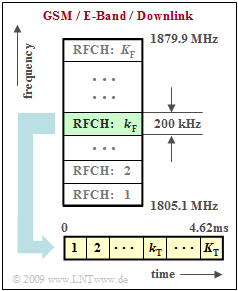The mobile communications standard $\rm GSM$ (Global System for Mobile Communications), which has been established in Europe since around 1992, uses frequency and time division multiplexing simultaneously to enable several subscribers to communicate in one cell.
Some characteristics of the GSM system are given below in a somewhat simplified form. A detailed description can be found in the third chapter of the LNTwww book Examples of Communication Systems. The download range of the so-called "E-network" in the frequency range around 1800 MHz is considered in this exercise.
- The frequency band of the downlink (i.e. the connection from the base station to the mobile station) is between 1805 MHz and 1880 MHz. Taking into account the guard bands at both ends (100 kHz each), a total bandwidth of 74.8 MHz is thus available for the uplink.
- This band is used by a total $K_{\rm F}$ subchannels (Radio Frequency Channels), which are adjacent to each other in terms of frequency with a respective spacing of 200 kHz. The numbering is done with the control variable $k_{\rm F}$.
- The frequency range for the uplink (the connection from a mobile station to the base station) is 95 MHz below the downlink and otherwise has exactly the same structure.
- Each of these FDMA subchannels is used simultaneously by $K_{\rm T}$ subscribers via TDMA (Time Division Multiple Access).
- Each subscriber has a time slot of duration $T ≈ 577 \ µ s$ available at intervals of 4.62 milliseconds. During this time, the (approximate) $156$ bits describing the speech signal must be transmitted, taking data reduction and channel coding into account.
Notes:
- The exercise belongs to the chapter Tasks and Classification.
- Reference is made in particular to the pages
OFDM system consideration in the time domain,
OFDM system consideration in the frequency domain with causal basic pulse.
Questions
Solution
(2) The center frequency of the first channel is 1805.2 MHz.
- The channel designated "RFCH100" is higher by 99 · 200 kHz = 19.8 MHz:
- $$f_{\rm M} = 1805.2 \,\,{\rm MHz } + 19.8 \,\,{\rm MHz } \hspace{0.15cm}\underline {= 1825 \,\,{\rm MHz }}.$$
(3) To be able to use the observations for subtask (2), we transform the exercise into the downlink.
- The same channel with the identifier $k_{\rm F}$, which uses the center frequency 1750 MHz in the uplink, is at 1845 MHz in the downlink.
- Thus applies:
- $$k_{\rm F} = 1 + \frac {1845 \,\,{\rm MHz } - 1805.2 \,\,{\rm MHz } }{0.2 \,\,{\rm MHz }}\hspace{0.15cm}\underline { = 200}.$$
(4) A TDMA frame of duration 4.62 milliseconds can accommodate eight time slots, each with duration $T = 577 \ µ s$.
- $K_{\rm T} = 8$ is also actually used in GSM.
(5) Using the results of subtasks (1) and (4), we obtain:
- $$K = K_{\rm F} \cdot K_{\rm T} = 374 \cdot 8 \hspace{0.15cm}\underline {= 2992} .$$
(6) During the time $T = 577 \ µ s$ 156 bits must be transmitted.
- Thus, the time $T_{\rm B} = 3.699 \ \rm µ s$ is available for each bit. This results in the bit rate
- $$R_{\rm Gross} = \frac {1 }{T_{\rm B}} \hspace{0.15cm}\underline {\approx 270 \,\,{\rm kbit/s }}.$$
- In addition to the data symbols describing the speech signal, this gross bit rate also includes the training sequence for channel estimation and the redundancy for channel coding.
- The net bit rate for the GSM system is only about $R_{\rm Net} = 13 \ \rm kbit/s$ for each of the eight users.
